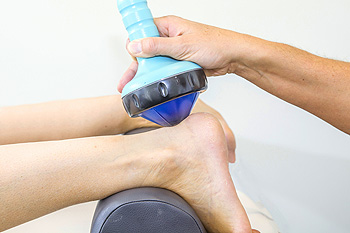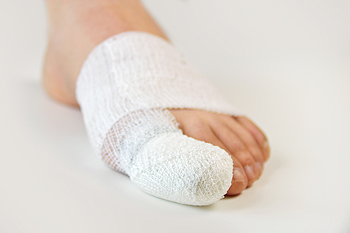Items filtered by date: July 2022
Infections Can Sometimes Be the Cause of Your Ankle Pain

There are many reasons why your ankle may hurt. You may have sprained, strained, or fractured your ankle, or ruptured your Achilles tendon. Perhaps some form of arthritis has settled into the ankle joint, or you may have fallen arches. A less common reason for ankle pain is an infection. You are more susceptible to developing an infection in your ankle if you have recently had surgery or have suffered a cut or other form of trauma in the area, and bacteria entered through the open skin. A painful ankle infection is sometimes accompanied by warmth, swelling, or redness in the affected area as well as fever and fatigue. Any infection is a potentially serious condition and should be attended to promptly. If you are having any of the symptoms mentioned here, it is suggested to make an appointment with a podiatrist. They will examine your ankle and make an accurate diagnosis in order to treat the condition properly.
Ankle pain can have many different causes and the pain may potentially be serious. If you have ankle pain, consult with Ramin Nadjafi, DPM from Advanced Podiatry Group. Our doctor will assess your condition and provide you with quality foot and ankle treatment.
Ankle pain is any condition that causes pain in the ankle. Due to the fact that the ankle consists of tendons, muscles, bones, and ligaments, ankle pain can come from a number of different conditions.
Causes
The most common causes of ankle pain include:
- Types of arthritis (rheumatoid, osteoarthritis, and gout)
- Ankle sprains
- Broken ankles
- Achilles tendinitis
- Achilles tendon rupture
- Stress fractures
- Tarsal tunnel syndrome
- Plantar fasciitis
Symptoms
Symptoms of ankle injury vary based upon the condition. Pain may include general pain and discomfort, swelling, aching, redness, bruising, burning or stabbing sensations, and/or loss of sensation.
Diagnosis
Due to the wide variety of potential causes of ankle pain, podiatrists will utilize a number of different methods to properly diagnose ankle pain. This can include asking for personal and family medical histories and of any recent injuries. Further diagnosis may include sensation tests, a physical examination, and potentially x-rays or other imaging tests.
Treatment
Just as the range of causes varies widely, so do treatments. Some more common treatments are rest, ice packs, keeping pressure off the foot, orthotics and braces, medication for inflammation and pain, and surgery.
If you have any questions, please feel free to contact our office located in Orlando, FL . We offer the newest diagnostic and treatment technologies for all your foot care needs.
Wearing Running Shoes for Fitness Walking
 The age-old question of what type of shoes to wear for walking, especially fitness walking, continues. While runners have different needs compared to fitness walkers, and some running shoes would not be appropriate for walking, some of the shoes designed for walking can be even worse. Some walking shoes are made more for comfort and work purposes than walking for fitness. These types of shoes are highly cushioned to relieve stress from standing and may be heavy and not as flexible as needed. Running shoes tend to have more of the latest developments in technology with respect to cushioning for fitness walking, as well as motion control, and support. When choosing a running shoe for fitness walking, running stores can help you determine if you need motion control shoes, stability shoes, or neutral, lightweight trainers. The shoe you get should bend some and be able to be flexed at the forefoot. Look for shoes of 10 mm or less of a heel-to-toe drop. Make sure the heel of the shoe is undercut and angles in from the heel to the ground rather than being flared. Most importantly, make sure they feel comfortable. For additional help picking the right shoe for your particular foot and the needs of fitness walking or any other exercise you plan to embark upon, visit a podiatrist, who can examine your feet and gait and make specialized recommendations.
The age-old question of what type of shoes to wear for walking, especially fitness walking, continues. While runners have different needs compared to fitness walkers, and some running shoes would not be appropriate for walking, some of the shoes designed for walking can be even worse. Some walking shoes are made more for comfort and work purposes than walking for fitness. These types of shoes are highly cushioned to relieve stress from standing and may be heavy and not as flexible as needed. Running shoes tend to have more of the latest developments in technology with respect to cushioning for fitness walking, as well as motion control, and support. When choosing a running shoe for fitness walking, running stores can help you determine if you need motion control shoes, stability shoes, or neutral, lightweight trainers. The shoe you get should bend some and be able to be flexed at the forefoot. Look for shoes of 10 mm or less of a heel-to-toe drop. Make sure the heel of the shoe is undercut and angles in from the heel to the ground rather than being flared. Most importantly, make sure they feel comfortable. For additional help picking the right shoe for your particular foot and the needs of fitness walking or any other exercise you plan to embark upon, visit a podiatrist, who can examine your feet and gait and make specialized recommendations.
For more information about walking shoes versus running shoes, consult with Ramin Nadjafi, DPM from Advanced Podiatry Group. Our doctor can measure your feet to determine what your needs are and help you find an appropriate pair of footwear.
Foot Health: The Differences between Walking & Running Shoes
There are great ways to stay in shape: running and walking are two great exercises to a healthy lifestyle. It is important to know that running shoes and walking shoes are not interchangeable. There is a key difference on how the feet hit the ground when someone is running or walking. This is why one should be aware that a shoe is designed differently for each activity.
You may be asking yourself what the real differences are between walking and running shoes and the answers may shock you.
Differences
Walking doesn’t involve as much stress or impact on the feet as running does. However, this doesn’t mean that you should be any less prepared. When you’re walking, you land on your heels and have your foot roll forward. This rolling motion requires additional support to the feet.
Flexibility – Walking shoes are designed to have soft, flexible soles. This allows the walker to push off easily with each step.
If you have any questions, please feel free to contact our office located in Orlando, FL . We offer the newest diagnostic and treatment technologies for all your foot care needs.
Keep Your Feet Healthy So You Can Stay Active
Using Sound Waves to Treat Plantar Fasciitis and Achilles Tendonitis

Extracorporeal Shock Wave Therapy (ESWT) is a non-invasive treatment for many painful and chronic conditions such as plantar fasciitis and Achilles tendonitis. This type of treatment is performed outside the body (extracorporeally) and works by targeting the damaged tissue or bone with acoustic shock waves using ultrasound to precisely pinpoint the area. The acoustic sound waves create a controlled reaction within the tissue that ultimately regenerates cells and blood vessels, resulting in repairing the tissue and relieving pain. Unlike surgery, ESWT requires no prolonged recovery time. If you are suffering from plantar fasciitis or a painful Achilles tendon issue, you might benefit from consulting with a podiatrist to discuss whether you are a good candidate for ESWT.
Shockwave therapy is a treatment commonly used to treat various injuries and conditions, particularly plantar fasciitis in the feet. To learn more, consult with Ramin Nadjafi, DPM from Advanced Podiatry Group. Our doctor can provide the care you need to keep you pain-free and on your feet.
Shockwave Therapy
Shockwave therapy is a new treatment option designed to treat bone conditions such as tennis elbow, shoulder pain, and others. Shockwave therapy uses high intensity sound waves that are directed to the affected tissues of the body with pinpoint accuracy. The effects are very beneficial, leading to a production of collagen fibers, eliminating inflammation.
Who Benefits from Shockwave?
Shockwave is recommended for patients suffering from heel pain and associated problems. Heel pain is a common condition which can be caused by obesity, overexertion, and spending a substantial amount of time on hard floors with your feet exposed and unsupported.
Fast and Easy
The therapy is actually a simple process that can leave patients feeling better the very next day. Shockwave therapy is not as dramatic as it sounds. It enables more blood flow to effected areas, addressing the source of the problem and allowing treatment to last for a long time.
Treatment & Recovery Time
Shockwave treatment will enable your feet to recover quickly. This is especially important since surgery is not required. It is cost effective and does not require the use of anesthesia. This treatment is a better option to surgery, since it is proven safe.
If you have any questions, please feel free to contact our office located in Orlando, FL . We offer the newest diagnostic and treatment technologies for all your foot and ankle needs.
Toe Fractures

Broken toes can be painful. There are 28 bones in the foot and 19 of them are toe bones. A toe fracture is a break in a toe bone. Toe fractures can either be traumatic or stress fractures. Traumatic toe fractures, also called acute fractures, are caused by a direct blow or impact, like badly stubbing a toe. These can be displaced, where the toe is broken in such a way that it changes position, or nondisplaced. When one has a traumatic toe fracture, there may be a sound when it breaks, the pain is typically at the site of impact, there may be a crooked or abnormal appearance to the toe, and it generally swells and bruises the next day. A stress fracture is a tiny, hairline break usually caused by repetitive stress to the toe. Athletes are often victims of toe stress fractures. They can be caused by an abnormal foot structure, osteoporosis, or improper footwear. These fractures cause pain with or after normal activity, pain at the site of the break when touched, and swelling but no bruising. Both types of toe fractures should be seen by a podiatrist who will provide a proper diagnosis and treatment.
Broken toes may cause a lot of pain and should be treated as soon as possible. If you have any concerns about your feet, contact Ramin Nadjafi, DPM from Advanced Podiatry Group. Our doctor will treat your foot and ankle needs.
What Is a Broken Toe?
A broken toe occurs when one or more of the toe bones of the foot are broken after an injury. Injuries such as stubbing your toe or dropping a heavy object on it may cause a toe fracture.
Symptoms of a Broken Toe
- Swelling
- Pain (with/without wearing shoes)
- Stiffness
- Nail Injury
Although the injured toe should be monitored daily, it is especially important to have a podiatrist look at your toe if you have severe symptoms. Some of these symptoms include worsening or new pain that is not relieved with medication, sores, redness, or open wounds near the toe.
If you have any questions, please feel free to contact our office located in Orlando, FL . We offer the newest diagnostic and treatment technologies for all your foot care needs.

